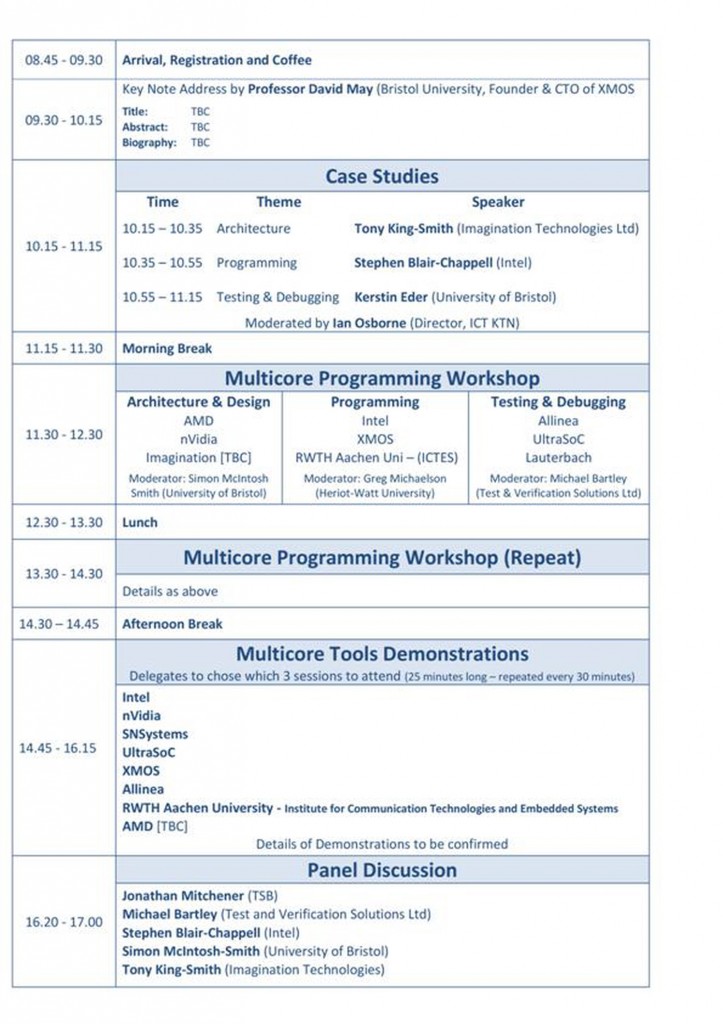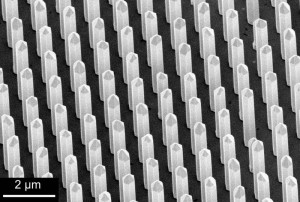Leading multicore silicon conference set for September in Bristol
Multicore Challenge Conference 2012
24 September 2012
Bristol (UWE, French Campus)
TVS and ICT KTN are holding the 2012 Multicore Challenge Conference on Monday, 24 September 2012 with speakers, case studies, workshops and tool demonstrations on the latest techniques and technologies for developing systems with multiple processor and graphics cores.
Leading speakers from Imagination, Intel and the University of Bristol will also be part of a panel session at the end of the day on the challenges of developing and using multicore silicon chips. Sign up here
Related articles
Bath researchers investigate energy network complexity
Researchers from Bath are looking at new ways to make the energy network more efficient and robust.
The team from the University’s Department of Computer Science, in collaboration with Low Carbon South West and Grid Scientific, has funding from the Technology Strategy Board (TSB) to investigate how a ‘coherence engine’ could enable operators to achieve significant business and operational benefits and will consider the specific scenario of responding to failures in the network more efficiently.
The introduction of Smart Power Distribution to energy networks, as part of the evolving Smart Grid initiative, will see a sharp increase in the number of systems that rely on sensors and other intelligent devices. A coherence engine may support Distribution Network Operators in extracting the maximum value from data provided by these devices.
The role of the coherence engine could be of importance as software enabled devices become more prevalent, data proliferates, fault symptoms become less obvious and network and operations complexity increases.
By developing an understanding of the anticipated operational and technical impacts of the introduction of these technologies, the researchers would be able to support Grid Scientific with its development of a coherence engine that could improve operations processes in distribution networks.
Low Carbon South West, a membership organisation which creates sector partnerships between businesses, academia, investors and local authorities to promote the growth of environmental technologies and services in the South West region, is leading the partnership and will also disseminate the partnership’s findings across it membership.
Board member Simon Bond said: “Current systems for monitoring faults in the energy network rely on their independent view of activity. As the network becomes more complex and new technologies are introduced, this lack of communication between monitoring systems could become problematic.
“Through this project the partners are aiming to determine the feasibility of a centralised view of the network which will address these complications and deal with a proliferation of network data.”
Grid Scientific, a company which designs software to support the evolution of today’s energy networks, has been investigating the potential of data coherence for energy networks over the last year. The company also draws on over 20 years of experience in telecoms networks where similar changes can be viewed as an analogue for the changes now expected in energy networks. If the feasibility study is encouraging, Grid Scientific plans to develop new data coherence products for the energy network market.
Eric Brown, Managing Director of Grid Scientific, said: “The challenges and opportunities we are now seeing in energy networks are similar to those seen in telecoms when major changes took place in that sector in the 1990s. However, substantial differences between the electricity and telecoms environments mean that a level of technical and operational innovation will be required,” he said. “We’ll be working with the research group to determine where the latest thinking in computer science can be applied to deliver solutions for energy networks.”
Dr Rachid Hourizi, researcher in human and system interaction from the University of Bath’s Department of Computer Science, said: “Understanding the feasibility of coherence to successfully meet the smart power distribution data challenges will depend on collaborative and cross discipline innovation from the electricity, IT and communications sectors. If feasibility can be shown, this project could lead to the construction of a prototype coherence engine for fault management and the extension of the approach to address improvement in other processes in the electricity network.”
Related articles
New £715K laboratory to advance cell research
A new £715K laboratory at the University of Bristol aims to equip scientists in the South West with the facilities they need to carry out the latest techniques in cell biology research.
A £715,000 grant from the Wolfson Foundation, coupled with significant investment from the University of Bristol, has enabled the refurbishment of space in the University’s School of Medical Sciences to provide a state-of-the art laboratory space for cell biologists.
The facility will house three research teams, led by Professor George Banting, Professor David Stephens and Dr Jon Lane, who share a common interest in understanding the molecular mechanisms that underlie cell function — how the tens of thousands of individual components within a cell work together for the cell to do its job.
Professors Banting and Stephens will use the facility to study how proteins are delivered to the right place(s) within cells, how they are exported from cells, and how cell membranes are organised. This research is fundamental to cell biology as it has implications for a range of disease states as well as for tissue organisation and responses to pathogen (bacterial and viral) infection.
Dr Lane’s lab applies an understanding of membrane and cytoskeletal dynamics to “autophagy” — a process of cellular quality control that is upregulated during cell stress. This process is vital for normal organismal development, but can give rise to degenerative diseases and cancer if it goes wrong.
Professor Leo Brady, Head of the University’s School of Biochemistry said: “Cells are the building blocks of most forms of life. This investment from the Wolfson Foundation helps to keep Bristol at the cutting edge in cell biology research.”
The refurbishment also provides bespoke space for sophisticated microscopy systems that have been purpose built within the Stephens and Lane research groups. These systems complement the excellent imaging equipment available in the nearby Wolfson Bioimaging Facility – this unique facility was funded from a £1 million investment from the Wolfson Foundation and completed in 2008. It is regularly used by around 100 research groups across the University. It is situated is in close proximity on the same floor as the new laboratory space.
Related articles
Bristol researchers aim for super-bright LEDs
Researchers in Bristol are working on a European project to increase the performance of white LEDs by a factor of 10 for brighter car headlights.
The €3.8m GECCO project aims to use vertical structures for the new LEDs. Modern high-performance LEDs already provide a bright light output at high efficiency and are used for automobile headlights. At present though, the production process for these kinds of LEDs is still not cost efficient enough and also the efficiency of these LEDs needs further improvement.
The international team of the GECCO project includes the Technical University of Braunschweig in Germany, Madrid, Lodz and lighting company OSRAM in Munich and Regensburg.
Up to now, LEDs are being constructed in a planar way, meaning in layers and completely flat. The more light is being required, the more wafer area has to be produced, which is an expensive and laborious approach. The aim of the GECCO project is to assemble LEDs in a three-dimensional way so that actually every LED consists of a ‘light emitting tower’ from which the entire vertical surface is emitting light. Obviously the surface of the tower is much larger compared to the ground area of a planar LED. And in fact, it is exactly the gain of light emitting area that leads to a higher light output.
This means the manufacturing of an LED becomes much more cost-effective and as a result replacing ancient electric bulbs, halogen lamps as well as energy saving bulbs to LEDs is getting a lot more profitable. Considering the fact that currently 20 % of electrical energy worldwide is being utilized for illumination, this innovation provides an enormous potential as far as cost-effectiveness is concerned. In addition, LED lighting is particularly important for future electric mobility, particularly for electric cars.
The dimensions of the ‘light emitting towers’ are within the micrometer range. This means approximately one million LEDs fit on an area of one square millimeter. This process requires utmost precision which can only be achieved by applying nanotechnology manufacturing techniques.
The GECCO project is coordinated by Prof. Andreas Waag from the Institute of Semiconductor Technology at Braunschweig.
Related articles
SouthWest crowdfunding helps City startup avoid venture capitalists
A London startup Escape the City has used Exeter-based crowd funding speciliasts Crowdcube to raise £600k in less then two weeks after turning down two offers of venture capital funding.
Initially the company raised £500k in 9 days and then extended the pitch by £100k to £600k, raising the extra tranche in under 4 days.
Ironically, Escape the City is a website that helps professionals to make career transitions. It has a community of more than 65,000 people who want to escape from unfulfilling corporate jobs – be it launching a start-up or joining a quirky company or non-profit organisation.
Related articles
Kickstarter startup funding to come to the UK
The Kickstarter crowdfunding scheme for startups and projects is aiming to come to the UK in the autumn.
The company offers start-ups a route to raise funding for specific projects from the general public in return for ‘investor’ benefits. A target amount to raise is set and if that amount is not reached, nothing is funded. Unlike Exeter-based crowdfunding venture Crowdcube, the benefits do not currently include shares.
The latest hit project on Kickstarter is Ouya, a low cost games console that comes with its own software development kit (SDK) so that it can be deliberately hacked (or programmed, as we used to say!). The $100 Android-based console is to the Raspberry Pi what the old ZX80 DIY computer kit was to the BBC B Microcomputer. Funders get their name engraved on their own console, or, for enough money, on the whole production run.
UK companies have been using Kickstater in the US. Xenonauts, a game by Goldhawk Interactive in London, last month raised $155,000 from nearly 5,000 small investors. However, in order to set up a Kickstarter account, you have to use Amazon Payments and in order to use Amazon Payments you have be an American citizen, and that has caused problems for international companies.
Related articles
Memorial for South West entrepreneur Kenn Lamb
Serial entrepreneur and stalwart supporter of South West innovation, Kenn Lamb, has lost his long fight against cancer. A memorial service will be held at the Memorial Woodlands, Earthcott Green, Alveston, Bristol, BS35 3TA on Thursday 19th July at 12 noon.
It was as CEO of Hewlett Packard spinout Elixent that saw him take on a wider role in the industry, building up the startup until Panasonic took over the business in 2006. His last role was CEO of Cambridge startup Cyan Technology, re-building the company while commuting from the SouthWest.
He started out at Plessey Semiconductors in Swindon, becoming data products manager, but moved into the electronic design tool industry at Comdisco and then Cadence Design Systems. Moving back into hardware he was the European General Manager at FPGA designer Actel (now part of MicroSemi) followed by roles at development system house Pentica Systems and IP developer Arc (now part of Synopsys).
He was a strong supporter of the industry and of the SouthWest, influencing and assisting many people throughout his career with his humour and expertise.
For information about the memorial please contact nick@flaherty.co.uk
GKN Opens Engineering Centre In Filton
GKN Aerospace has opened a new engineering and technology center at its site at Filton near Bristol. The centre is GKN’s fourth and will focus on future wing structure design and manufacture. The company expect to increase the engineers on the site from 5 to over 100.
via GKN Opens Engineering Center In Filton, UK | Aviation International News.
SouthWest engineering technology reveals secrets of Roman coins

Computer rendered image of the coins extracted from the CT scan data of the complete pot from the Selby Area Hoard’ Credit: University of Southampton.
Engineers from the University of Southampton are collaborating with the British Museum to examine buried Roman coins using the latest X-ray imaging technology.
The powerful scanning equipment at Southampton’s µ-VIS Centre for Computed Tomography is being used to examine Roman coins buried in three archaeological artefacts from three UK hoards.
The centre’s equipment can scan inside objects – rotating 360 degrees whilst taking thousands of 2D images, which are then used to build detailed 3D images. In the case of the coins, the exceptionally high energy/high resolution combination of the Southampton facilities allows them to be examined in intricate detail without the need for physical excavation or cleaning. For those recently scanned at Southampton, it has been possible to use 3D computer visualisation capabilities to read inscriptions and identify depictions of emperors on the faces of the coins – for example on some, the heads of Claudius II and Tetricus I have been revealed.
“Excavating and cleaning just a single coin can take hours or even days, but this technology gives us the opportunity to examine and identify them quickly and without the need for conservation treatment at this stage. It also has potential for examining many other archaeological objects,” said University of Southampton archaeologist, Dr Graeme Earl. “The University’s Archaeological Computing Research Group can then take this one step further – producing accurate, high resolution CGI visualisations based on scan data. This gives archaeologists and conservators around the world the opportunity to virtually examine, excavate and ‘clean’ objects.”
The scanning technique is already yielding some fascinating results and the possibility of identifying a hoard of coins in a pot, without removing them, is very exciting, says Dr Roger Bland, Head of Portable Antiquities and Treasure at the British Museum.
The three objects examined at Southampton are:
- A cremation urn containing nine coins, dating from AD282, found in the Cotswolds. This item in particular would take months to excavate – with archaeologists needing to carefully examine bone fragments and remains to extract more information about its past.
- An estimated 30,000 Roman coins discovered in Bath, dating to around AD270 and concreted together in a large block weighing over 100 kilograms (radiograph image only).
- A small pot dating to the 2nd century found in the Selby area of East Riding in Yorkshire.
“Our centre examines a wide variety of objects from the layup of individual carbon fibres in aircraft wing components, to the delicate roots of growing plants, and now ancient Roman coins. It is our integration of state-of-the-art imaging hardware, world-class computing and image processing expertise, which allows us to break new ground,” said Professor Ian Sinclair, director of the µ-VIS Centre for Computed Tomography. “We have recently formed an inter-disciplinary research group for Computationally Intensive Imaging, which brings together a broad spectrum of world-class imaging activities from disciplines across the University – of which this project is an excellent example.”
The University of Southampton and the owners of the artefacts have plans to share the scan data with the public, hopefully through future exhibitions and online.
Related articles
New creative sector hub for Bristol
Bristol is host to one of four new Knowledge Exchange Hubs for the Creative Economy launched today by the Arts and Humanities Research Council (AHRC).
The Research and Enterprise in the Arts and Creative Technologies – REACT – centre is led by UWE Bristol with a consortium that includes the Universities of Bristol, Exeter, Bath and Cardiff and the Watershed Arts Trust.
REACT will also work closely with creative businesses, including SMEs, arts and culture organisations and other agencies.
REACT is directed by Professor Jon Dovey and based in Watershed’s Pervasive Media Studio.
Creative sector hub set up in Bristol.







































